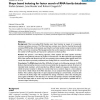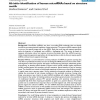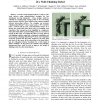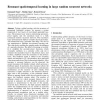282 search results - page 35 / 57 » On predicting secondary structure transition |
BMCBI
2008
13 years 7 months ago
2008
Background: Most non-coding RNA families exert their function by means of a conserved, common secondary structure. The Rfam data base contains more than five hundred structurally ...
BMCBI
2007
13 years 7 months ago
2007
Background: MicroRNAs (miRNAs) are short, non-coding RNA molecules that are directly involved in post-transcriptional regulation of gene expression. The mature miRNA sequence bind...
ICRA
2008
IEEE
14 years 2 months ago
2008
IEEE
— Several recently-designed robots are able to scale steep surfaces using animal-inspired strategies for foot attachment and leg kinematics. These designs could be valuable for r...
BC
2002
13 years 7 months ago
2002
Taking a global analogy with the structure of perceptual biological systems, we present a system composed of two layers of real-valued sigmoidal neurons. The primary layer receives...
CSB
2005
IEEE
14 years 1 months ago
2005
IEEE
Metals bound to the protein are important for functional or structural roles. Despite their importance there is a distinct lack of research for identification of metalloproteins f...




